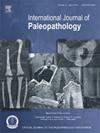19至20世纪瑞士里吉斯堡济贫院墓地的地方性先天性缺碘综合症
IF 1.5
3区 地球科学
Q3 PALEONTOLOGY
引用次数: 0
摘要
目的鉴定和描述显示先天性碘缺乏综合征(CIDS)特征的骨骼遗骸,也被称为“克汀病”,并探讨这种疾病是否可能被诊断不足,或者是否在考古骨骼组合中代表性不足。材料:来自19 /20世纪前里吉斯堡济贫院墓地的121具成人骨骼。方法采用标准的骨学方法对遗骨进行宏观研究,估计其年龄、性别和身高。结果在4个个体中检测到典型的CIDS特征,另外6个个体,我们认为这是一个高度一致的诊断。对来自2314个考古骨骼比较样本的古病理学数据的回顾显示,CIDS患者的代表性不足,但也有线索表明,以前未诊断的病例可能存在。我们认为,在流行地区的考古记录中,代表性不足可能是由于受影响个体的儿童死亡率增加,在未成熟的骨骼遗骸中诊断这种疾病的困难,以及-至少在现代时期-频繁的机构和埋葬在属于机构的特定墓地。意义:几例新的CIDS病例增加了已知受累遗骸的小体,增加了对其骨骼表现的认识。本研究有助于一种几乎被根除的疾病的鉴别诊断及其在过去人群中的评估。保存完整的骨骼限制了评估和诊断。对进一步研究的建议建议对骨骼进行进一步深入的审查和精确的评估,以解释考古学上对疾病的代表性不足。本文章由计算机程序翻译,如有差异,请以英文原文为准。
Endemic congenital iodine deficiency syndrome from a 19th to 20th century poorhouse cemetery in Riggisberg, Switzerland
Objective
To identify and describe skeletal remains showing features consistent with congenital iodine deficiency syndrome (CIDS), also known as "cretinism" and to explore whether this condition may have been underdiagnosed or if it is underrepresented in archaeological skeletal assemblages.
Materials
121 adult skeletons from the 19th/20th century former Riggisberg poorhouse cemetery.
Methods
The remains were studied macroscopically using standard osteological methods for the estimation of age, sex and stature.
Results
Features typical of CIDS were detected in four individuals, and for another six, we consider it a highly consistent diagnosis. The review of palaeopathological data from a comparative sample of 2314 archaeological skeletons revealed an underrepresentation of individuals with CIDS but also clues that previously undiagnosed cases may exist.
Conclusions
We suggest that an underrepresentation in the archaeological record of endemic regions may be due to increased childhood mortality of affected individuals, difficulties in diagnosing this condition in immature skeletal remains, and – at least in the modern period – frequent institutionalization and burial in specific cemeteries belonging the institutions.
Significance
Several new cases of CIDS increase the small body of known affected remains and add to the knowledge about its skeletal manifestations. This study contributes to the differential diagnosis of a nearly eradicated disease and to its assessment in past populations.
Limitations
Incompletely preserved skeletons limited the assessment and diagnosis.
Suggestions for further research
Further intensive review and precise assessment of skeletons is advised to explain archaeological underrepresentation of diseases.
求助全文
通过发布文献求助,成功后即可免费获取论文全文。
去求助
来源期刊

International Journal of Paleopathology
PALEONTOLOGY-PATHOLOGY
CiteScore
2.90
自引率
25.00%
发文量
43
期刊介绍:
Paleopathology is the study and application of methods and techniques for investigating diseases and related conditions from skeletal and soft tissue remains. The International Journal of Paleopathology (IJPP) will publish original and significant articles on human and animal (including hominids) disease, based upon the study of physical remains, including osseous, dental, and preserved soft tissues at a range of methodological levels, from direct observation to molecular, chemical, histological and radiographic analysis. Discussion of ways in which these methods can be applied to the reconstruction of health, disease and life histories in the past is central to the discipline, so the journal would also encourage papers covering interpretive and theoretical issues, and those that place the study of disease at the centre of a bioarchaeological or biocultural approach. Papers dealing with historical evidence relating to disease in the past (rather than history of medicine) will also be published. The journal will also accept significant studies that applied previously developed techniques to new materials, setting the research in the context of current debates on past human and animal health.
 求助内容:
求助内容: 应助结果提醒方式:
应助结果提醒方式:


